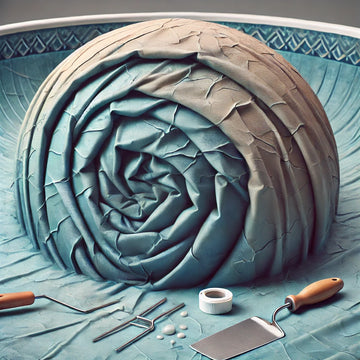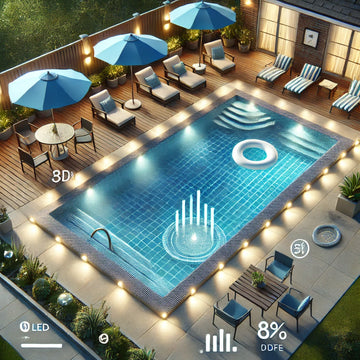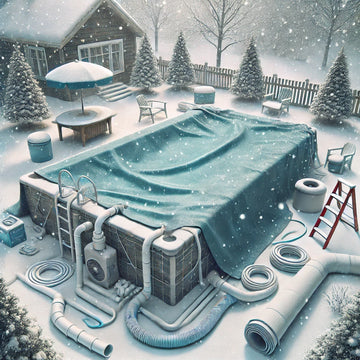Take a second and think of what the perfect pool looks like. You’re probably picturing a pool with a smooth base and crisp, sparkling water – and definitely not dirty murky water.
Life isn’t perfect, though, and your pool won’t always look like it came straight out of a brochure. Unfortunately, clear pool water tends to lose its sparkle and takes on a murky green or dirt-like brown colour.
Fortunately, it’s not hard to fix this problem – even if you’ve seen discolouration for a long time.
Read below for our step-by-step guide on how to restore a pool’s clear and crisp water colour.
Why Does Pool Water Turn Green or Brown?
Your pool’s water has taken on a strange colour – and now, you have questions. Is the water safe? Is there a chemical imbalance? Will the original colour ever return?
Truthfully, there are a few reasons why you may see discoloured water in your pool.
Green water could indicate that your pool has algae buildup – a common problem for pool owners. Algae is an aquatic organism that can appear as a mushy, green substance – though it is often hard to identify unless you see it in large quantities.
It’s also possible that coloured water is the result of heavy metal oxidization. You could have too much copper, iron, silver, manganese, or magnesium in your pool. These metals can turn your pool green or yellow, or even stranger colours like black or purple. They are not particularly harmful, but still indicate that your water is not at its peak health.
Another reason could be pollen. Often, large amounts of pollen can turn your pool water a green/brown colour.
If enough dirt or debris contaminates your water, it may take on an unsavoury colour. This is usually noticeable in the texture of your water along with its colour.
How to Fix Pool Discolouration
With so many potential causes of pool discolouration, the best practice is to take a thorough, step-by-step approach. Checking every potential cause and taking every measure is the best way to ensure that you catch the cause of your issue in its tracks.
Step 1: Use Chlorine or Algaecide to Kill Algae
One of the most common reasons for pool discolouration is algae. This green organism can rapidly take over your pool, changing the water and your comfort level.
Regularly maintaining a good level of chlorine is the best way to avoid this problem, but unstable weather conditions can increase your risk of developing algae, regardless of how hard you try to stop it.
Fortunately, algae problems are fairly easy to get rid of if you are consistent. Chlorine and algaecide can help you eliminate algae, hopefully returning your pool water to its original colour.
Step 2: Brush the Walls and Floor
Brushing the wall & bottom profile of your pool helps ensure that any algae on your liner gets sloughed off into the water. This is crucial, so that the chlorine you used in step one can kill the algae. By shocking and detaching the algae from the liner and mixing it up like a big soup, your chances of killing the algae are much higher.
If the cause of your water discolouration is, in fact, algae, the algae will then turn a gray colour. If it does not turn gray, then the issue is most likely metal or pollen.
These issues can be resolved using a metal remover or a floc/sparkle/clarifier.
Step 3: Test Water for pH and Alkalinity
Testing your water for chemical imbalances is something you should always do right away under any circumstances, as your pH levels or other chemicals may indicate a problem linked to the colour of your pool water.
Even if your pool water is green or black, by balancing the water right away, the chlorine will be more effective at killing the algae
High pH or high alkalinity can give your pool’s water a cloudy or milky appearance. This happens because dissolves minerals become solidified. Water with a low pH level can cause cracks to appear in the pool’s liner, and the debris coming from that may also affect the appearance of the water.
Step 4: Vacuum Your Pool
If your pool is facing any contamination issues, vacuuming is one of the first steps you should take. Cleaning surfaces can remove many of the causes associated with discolouration – in fact, it’s possible that what you’re perceiving as discolouration is actually influenced to some degree by the state of your pool’s floor or liner.
Even without the fear of discolouration, vacuum your pool whenever possible to improve the quality of your water.
Step 5: Test Your Filter System
Finally, it’s possible that your filter system is the cause of your water’s yucky appearance. If it is broken or installed incorrectly, it may be leaving debris in your pool, causing the water to turn darker. Ensure that your pool’s filtration system is working and installed correctly.
In cases were water always stays murky no matter what you do, you may need to change your cartridge or sand in the filter. Also try using a Nature2 water purifier system to help bring the water to an even more clear state.
The Takeaway
After taking the steps listed above, you’ll be able to tell the difference easily – a clear, glimmering pool is much more enjoyable to swim in and lounge around than a murky, cloudy pool.
Still not sure why your pool water is discoloured? Not sure where to start?
At HB Pools, our team of pool maintenance and installation experts know all about the trials and tribulations that come with strange happenings in your pool. Contact us to get one step closer to enjoying your pool the way you should.




